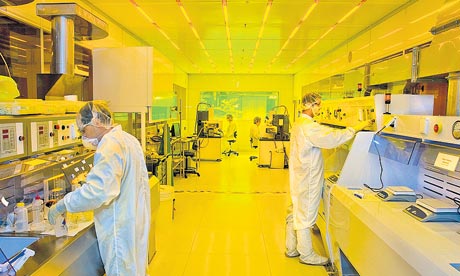Molecular nanotechnology could allow us to build the products we need with the sort of precision that right now only nature can do.
Mimicking nature is a recurring theme in nanotechnology and molecular nanotechnology, inspired by the natural nanostructures found in our own bodies, offers many exciting potential outcomes.
"Molecular nanotechnology is the expected ability to build our products with molecular-level precision, as nature can do," says Christine Peterson, president of the Foresight Nanotech Institute in California. "It will bring unprecedented quality, energy efficiency and environmental sustainability".
The recent development of an electron-powered molecular "nanocar", by a team led by chemist Ben Feringa at the University of Groningen in the Netherlands, hints at the potential. Further indications that molecular nanotechnology is achievable are being found in the quest for ever-smaller computing.
Many of these efforts attempt to use nature's own method of storing and transferring information – DNA. "DNA computing is the goal of building devices out of DNA that are able to act like computers, initially doing simple calculations but eventually doing everything that a macroscale computer can do," says Peterson.
In October, researchers at Imperial College London built basic computing components using DNA and a common bacterium, while New York University scientists created new, artificial DNA structures capable of encoding and transferring simple information. If scientists can crack techniques such as DNA computing, the next step could be nanomotors that can be controlled to deliver treatments to specific cells or even repair damaged DNA. "We can be confident that human-made nanomachines will be able to repair DNA because we see natural nanomachines doing it now. They just need some help," says Peterson.
One future prospect for molecular-scale nanotechnology is to build nanofactories. "The nanofactory is a proposed compact molecular manufacturing system that could build a diverse selection of large-scale, atomically precise products," explains Robert Freitas Jr, senior research fellow at the Institute for Molecular Manufacturing, also in California. "The products of a nanofactory would be atomically precise, with every atom in exactly the right place, offering the ultimate in quality control. It could make products out of the strongest materials known to man – especially diamond, sapphire, and related ultra-strong ceramics. In manufacturing, it's hard to do better than that."
The first two-dimensional structure to be built atom-by-atom was made from silicon in 2003. However, Freitas says nanofactories are still a long way off. "We expect this will require a 20-year research and development effort and on the order of $1bn (£622m) in funding to achieve."
Benefits and risks
"People are always worried about risk, but on balance the benefits of nanotechnology seem to greatly outweigh the risks," says Freitas. "Responsible developers are always seeking ways to deliver maximum benefits at minimum risk. This is not just good business – it's the right thing to do."
Vincenzo Balzani, professor of Chemistry at the University of Bologna, says much is down to the scientists involved. "Scientists have a great responsibility. They should refuse to use their science for bad applications." He says it is the political context, rather than nanotechnology itself, that will determine the dangers of tomorrow's discoveries.


No hay comentarios.:
Publicar un comentario